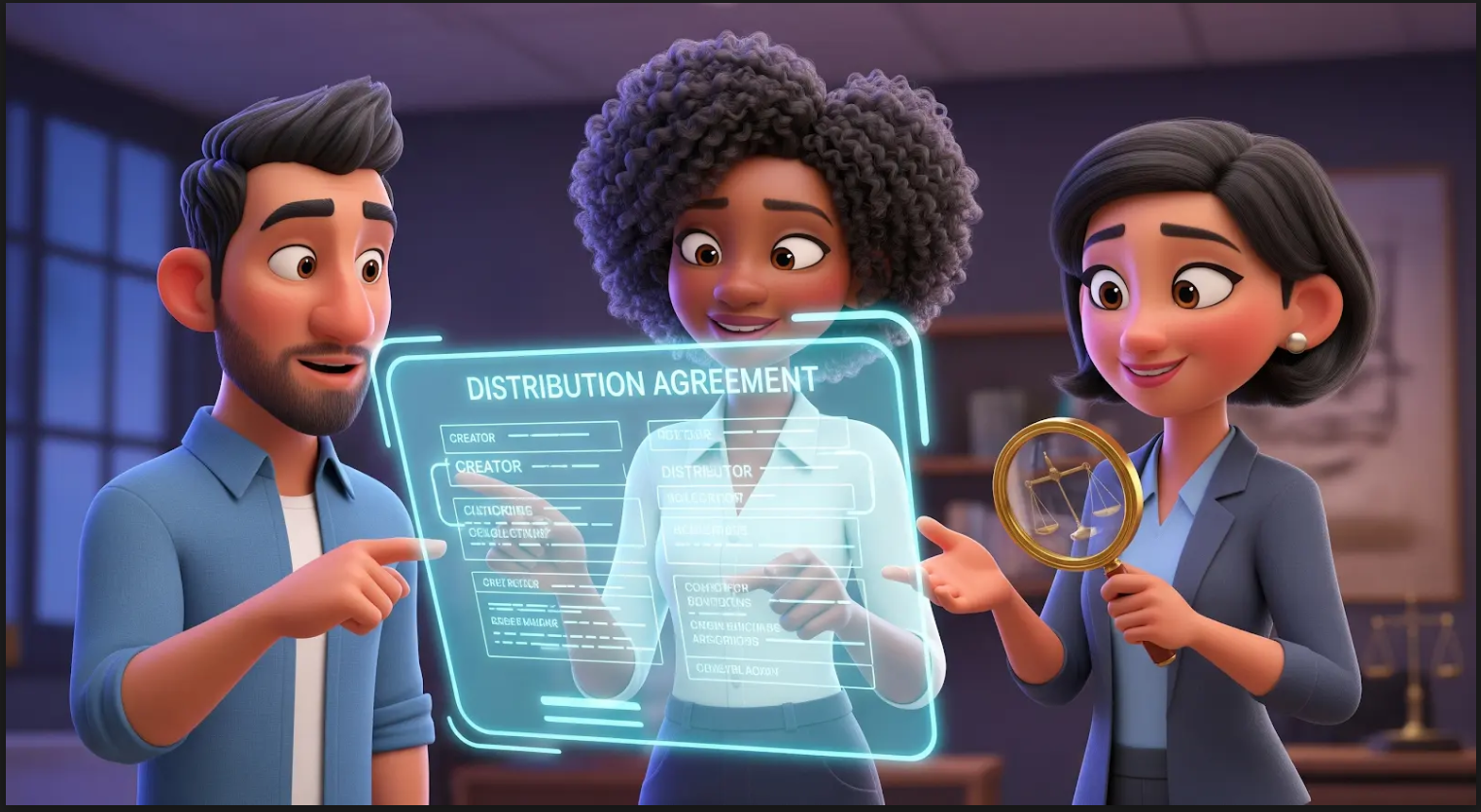Introduction
For content creators, securing a distribution agreement is the culmination of years of hard work, creative passion, and financial investment. It’s the critical bridge that takes a film or TV series from the realm of production to the hands of an audience.
Yet, beneath the celebratory headlines, lies a complex legal document – the distribution agreement – that dictates the financial realities, territorial reach, and ultimate fate of your intellectual property.
For both creators (licensors) and distributors (licensees), a thorough understanding of its key clauses is not just advisable, but absolutely essential to protect rights, maximize revenue, and avoid costly disputes. Ignoring the fine print can turn a dream deal into a financial nightmare.
The Foundational Purpose of a Distribution Agreement
At its core, a distribution agreement is a contract in which a content owner grants a distributor the right to exploit their content (film, TV series, documentary, etc.) within specified territories, across defined platforms, for a particular duration, in exchange for a fee or a share of revenues. It’s a license, not a sale of ownership, but the terms of that license are paramount.
Let’s dissect the critical clauses that every creator and distributor must understand in detail:
- Grant of Rights (The Scope of the Deal):
- What it is: This is arguably the most crucial clause. It explicitly defines which rights are being granted (e.g., theatrical, home video, broadcast TV, SVOD, AVOD, educational, non-theatrical, merchandise), for which territories (e.g., North America, Western Europe, Worldwide excluding China), and for which duration (the “Term” – e.g., 7 years, in perpetuity).
- Why it matters: As a creator, you want to ensure you’re only granting what’s necessary and retaining all other rights (e.g., remake, sequel, interactive). As a distributor, you need to ensure you have all the necessary rights to effectively exploit the content in your chosen markets. Ambiguity here leads to instant conflict. Be wary of broad “all rights, all media, known or unknown” language without clear limitations.
- Territory:
- What it is: Specifies the geographic areas where the distributor has the exclusive (or non-exclusive) right to exploit the content.
- Why it matters: Creators must track which territories are licensed to whom to avoid overlapping grants. Distributors need clear boundaries to ensure they aren’t infringing on another distributor’s territory and to focus their marketing efforts.
- Term (Duration of the License):
- What it is: The length of time the distributor holds the rights.
- Why it matters: Short terms (3-5 years) offer creators more flexibility to reclaim and re-license rights if the film performs well or market conditions change. Longer terms (7-10+ years, or “in perpetuity” for some major deals) offer distributors more security but tie up the creator’s asset. Be very cautious about “in perpetuity” clauses, especially for films with long-term potential.
- License Fee / Minimum Guarantee (MG):
- What it is: The upfront payment the distributor pays to the licensor. An MG is an advance against future royalties – the distributor keeps 100% of revenues until the MG is recouped, after which royalties kick in.
- Why it matters: This is often the immediate financial benefit for the creator and a key component of financing. For distributors, it’s the cost of entry. Negotiate the MG carefully, understanding that a higher MG means less risk for the creator but potentially longer recoupment for the distributor before royalties flow.
- Royalty Split / Revenue Share (The Back-End):
- What it is: The percentage split of revenues after the MG and certain recoupable expenses (see below) have been paid. Typical splits can range from 20-40% for the licensor, 60-80% for the distributor, but vary wildly by deal type, content, and leverage.
- Why it matters: This is where the long-term earnings for the creator lie. Scrutinize what “gross revenue” or “net receipts” truly mean and what expenses can be deducted.
- Recoupable Expenses / Deductible Costs:
- What it is: The expenses the distributor can deduct from the film’s gross revenues before calculating the royalty split or recouping the MG. These typically include marketing and P&A (Prints & Advertising), mastering, dubbing/subtitling, delivery costs, and sometimes a distribution fee.
- Why it matters: This is where a lot of disputes arise. Creators must demand clear limits and transparency. Cap P&A expenses, require approval for significant expenditures, and understand all deductible costs. An unchecked expense clause can lead to a film never “going into profit” no matter how much it earns, a phenomenon known as “Hollywood accounting.”
- Delivery Materials:
- What it is: A detailed list of all physical and digital assets the licensor must provide to the distributor (e.g., master video files, audio stems, trailers, artwork, publicity stills, music cue sheets, chain of title documents).
- Why it matters: Failure to deliver materials exactly as specified can lead to delays, additional costs (often charged back to the licensor), or even termination of the agreement. Distributors need this clear list to fulfill their exploitation obligations.
- Representations and Warranties / Indemnification:
- What it is: Clauses where the licensor “warrants” (guarantees) they own all necessary rights, that the content doesn’t infringe on third-party IP, and that it isn’t defamatory, etc. The “Indemnification” clause means the licensor agrees to protect the distributor from any legal costs or damages if a breach of these warranties occurs.
- Why it matters: This is the distributor’s primary protection against legal claims. For creators, this underscores the absolute necessity of a clear “chain of title” and proper rights clearance for every element of the film.
- Reporting and Audit Rights:
- What it is: Specifies how often the distributor must provide sales reports (e.g., quarterly, semi-annually) and outlines the licensor’s right to audit the distributor’s books to verify those reports.
- Why it matters: Transparency is key. Regular, detailed reports allow creators to track performance. Audit rights, though rarely exercised due to cost, are a crucial deterrent against opaque accounting practices.
- Marketing and Promotion Obligations:
- What it is: While distributors are responsible for marketing, this clause can outline minimum P&A commitments, requirements for promotional materials, and approval rights over key marketing campaigns.
- Why it matters: Creators want assurance that their film will be adequately promoted. Distributors need flexibility but can agree to certain benchmarks.
- Termination Clauses:
- What it is: Outlines conditions under which either party can terminate the agreement (e.g., material breach, failure to pay, insolvency).
- Why it matters: Provides an exit strategy for both parties if the other fails to uphold their end of the bargain.
- Governing Law and Dispute Resolution:
- What it is: Specifies which jurisdiction’s laws will apply to the agreement and how disputes will be settled (e.g., mediation, arbitration, litigation in a specific court).
- Why it matters: Critical for international deals, as it determines the legal framework for interpreting the contract and resolving conflicts.
The Imperative of Legal Counsel
Navigating these complex clauses requires expert legal guidance. Never sign a distribution agreement without a qualified entertainment lawyer reviewing every single line. They can identify red flags, negotiate more favorable terms, and protect your long-term interests. For distributors, meticulously drafted agreements minimize future legal exposure and ensure clarity with licensors.
In the dynamic world of content, a well-understood and fairly negotiated distribution agreement is not just a piece of paper; it’s the mutually agreed-upon blueprint for a project’s commercial journey, ensuring that both creative vision and business viability can flourish.
















































